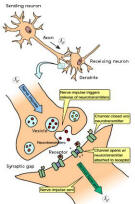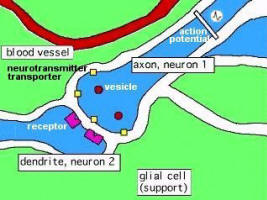Neurotransmitters
continued from the Brain PageContents
Neurons and Nervesneurotransmitter
The Brain & Spinal Cord
Cranial Nerves
Peripheral Nervous System
Autonomic Nervous System
Senses:Eye diagrams,Hearing,Smell,Taste, Taste & Tongue Sensation,Balance
Memory , Memory types, Creation of Memory
Higher Functions
Altered States
Neurotransmitters are chemicals that take a nerve signal across the synaptic gap (Figure 02a) between a sending neuron, and a receiving one. On the receiving neuron are receptors into which the neurotransmitters fit like a key in a lock. Once a neuro-transmitter is bound to its specific receptor, the likelihood of the receiving cell "firing" to send its own message is affected. The excitatory neurotransmitter-receptor systems make receiving cells more likely to fire, whereas the inhibitory systems make the 

firing less likely (see Figure 29a). It all depends on the type of neurotransmitter. An individual nerve cell can possess both kinds of synaptic connections (with a total of about 50000 synapses on the surface) to other nerve cells. Only if the excitatory charges (positive charge) exceed a threshold does the target neuron starting a nerve impulse of its own and is known as transduction. Figure 02b shows the various components in the synapse. The vesicle contains the neuro-transmitters in the axon. The receptor is located on the surface of the dendrite to pick up the neuro-transmitters. The
Figure 02a Synapse
[view large image]
Figure 02b Neurotransmitter
[view large image]
transporter is for recycling un-used neutrotransmitters back into the axon; while the glial cell provides nutrition and support for the neurons.
Figure 02c shows the process of signal transmission across the synapse:

Figure 02c Signal Transmission
[view large image]
There are other ways to turn the signal off. One is simple diffusion into the extracellular space. Another way is to break down the neuro-transmitters with enzymes. Then there are the presynaptic autoreceptors
Since the neurotransmitters are more accessible than the neuron itself, it can be subjected to a lot of internal and external